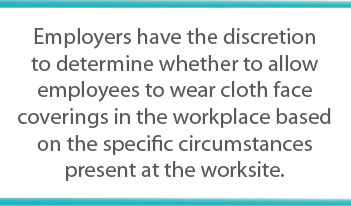By Sam Celly, BChE MChE JD CSP, Celly Services, Inc.
What are the key differences between cloth face coverings, surgical masks, and respirators?
Cloth face coverings:
- May be commercially produced or improvised (i.e., homemade) garments, scarves, bandanas or items made from t-shirts or other fabrics.
- Are worn in public over the nose and mouth to contain the wearer’s potentially infectious respiratory droplets produced when an infected person coughs, sneezes, or talks and to limit the spread of SARS-CoV-2, the virus that causes Coronavirus Disease 2019 (COVID-19), to others.
- Are not considered personal protective equipment (PPE).
- Will not protect the wearer against airborne transmissible infectious agents due to loose fit and lack of seal or inadequate filtration.
- Are not appropriate substitutes for PPE, such as respirators (e.g., N95 respirators) or medical face masks (e.g., surgical masks) in workplaces where respirators or face masks are recommended or required to protect the wearer.
- May be used by almost any worker, although those who have trouble breathing or are otherwise unable to put on or remove a mask without assistance should not wear one.
- May be disposable or reusable after proper washing.
Surgical masks:
- Are typically cleared by the U.S. Food and Drug Administration as medical devices (though not all devices that look like surgical masks are medical-grade, cleared devices).
- Are used to protect workers against splashes and sprays (i.e., droplets) containing potentially infectious materials. In this capacity, surgical masks are considered PPE. Under OSHA’s PPE standard (29 CFR 1910.132), employers must provide any necessary PPE at no cost to workers.1
- May also be worn to contain the wearer’s respiratory droplets
- Will not protect the wearer against airborne transmissible infectious agents due to loose fit and lack of seal or inadequate filtration.
- May be used by almost anyone.
- Should be properly disposed of after use.
Respirators(2) (e.g., filtering facepieces):
- Are used to prevent workers from inhaling small particles, including airborne transmissible or aerosolized infectious agents.
- Must be provided and used in accordance with OSHA’s Respiratory Protection standard (29 CFR 1910.134).
- Must be certified by the National Institute for Occupational Safety and Health (NIOSH).
OSHA has temporarily exercised its enforcement discretion concerning supply shortages of disposable filtering facepiece respirators (FFRs), including as it relates to their extended use or reuse, use beyond their manufacturer’s recommended shelf life, use of equipment from certain other countries and jurisdictions and decontamination.
Need proper filter material (e.g., N95 or better) and, other than for loose-fitting powered, air-purifying respirators (PAPRs), tight fit (to prevent air leaks).
Require proper training, fit testing, availability of appropriate medical evaluations and monitoring, cleaning, and oversight by a knowledgeable staff member. Automotive body shops are mandated to follow this requirement when refinishing automobiles.
OSHA has temporarily exercised its enforcement discretion concerning annual fit testing requirements in the Respiratory Protection standard (29 CFR 1910.134), as long as employers have made good-faith efforts to comply with the requirements of the standard and to follow the steps outlined in the March 14, 2020, and April 8, 2020, memoranda (as applicable to their industry).
When necessary to protect workers, require a respiratory protection program that is compliant with OSHA’s Respiratory Protection standard (29 CFR 1910.134). OSHA consultation staff can assist with understanding respiratory protection requirements.
- FFRs may be used voluntarily if permitted by the employer. If an employer permits voluntary use of FFRs, employees must receive the information contained in Appendix D of OSHA’s Respiratory Protection standard (29 CFR 1910.134).
Are employers required to provide cloth face coverings to workers?
Cloth face coverings are not considered personal protective equipment (PPE) and are not intended to be used when workers need PPE for protection against exposure to occupational hazards. As such, OSHA’s PPE standards do not require employers to provide them.
- The General Duty Clause, Section 5(a)(1) of the Occupational Safety and Health Act, requires each employer to furnish to each of his employees’ employment and a place of employment which are free from recognized hazards that are causing or are likely to cause death or serious physical harm. Control measures may include a combination of engineering and administrative controls, safe work practices like social distancing and PPE. We at CSI recommend that employers provide face protection at no cost to employees and enforce mandatory usage. Visitors should be provided with masks at no cost and be required to wear them while on the premises. Certain counties and cities have mandated their use by all when in a commercial establishment.
- When transmission risk cannot be controlled through engineering or administrative controls, including social distancing, employers can use cloth face coverings as a means of source control.
Should workers wear a cloth face covering while at work, in accordance with the Centers for Disease Control and Prevention recommendation for all people to do so when in public?
OSHA generally recommends that employers encourage workers to wear face coverings at work. Face coverings are intended to prevent wearers who have Coronavirus Disease 2019 (COVID-19) without knowing it (i.e., those who are asymptomatic or pre-symptomatic) from spreading potentially infectious respiratory droplets to others. This is known as source control.
Consistent with the Centers for Disease Control and Prevention (CDC) recommendation for all people to wear cloth face coverings when in public and around other people, wearing cloth face coverings, if appropriate for the work environment and job tasks, conserves other types of personal protective equipment (PPE), such as surgical masks, for healthcare settings where such equipment is needed most.
Employers have the discretion to determine whether to allow employees to wear cloth face coverings in the workplace based on the specific circumstances present at the worksite. For some workers, employers may determine that wearing cloth face coverings presents or exacerbates a hazard. For example, cloth face coverings could become contaminated with chemicals used in the work environment, causing workers to inhale the chemicals that collect on the face covering. Over the duration of a work shift, cloth face coverings might also become damp (from workers breathing) or collect infectious material from the work environment (e.g., droplets of other peoples’ infectious respiratory secretions). Workers may also need to use PPE that is incompatible with the use of a cloth face covering (e.g., an N95 filtering facepiece respirator).
Where cloth face coverings are not appropriate in the work environment or during certain job tasks (e.g., because they could become contaminated or exacerbate heart illness), employers can provide PPE, such as face shields or surgical masks, instead of encouraging workers to wear cloth face coverings. Like cloth face coverings, surgical masks and face shields can help contain the wearer’s potentially infectious respiratory droplets and limit the spread of COVID-19 to others.
Note that cloth face coverings are not considered PPE and cannot be used in place of respirators when respirators are otherwise required.
Learn more about cloth face coverings on the CDC website.
Employers should consider evaluating their accessible communication policies and procedures to potentially provide masks with clear windows to facilitate interaction between employees and members of the public who need to lip-read to communicate.
If I wear a reusable cloth face covering, how should I keep it clean?
CDC provides guidance on washing face coverings. OSHA suggests following those recommendations and always washing or discarding cloth face coverings that are visibly soiled.
In general, employers should always rely on a hierarchy of controls that first includes efforts to eliminate or substitute out workplace hazards and then uses engineering controls (e.g., ventilation, wet methods), administrative controls (e.g., written procedures, modification of task duration), and safe work practices to prevent worker exposures to respiratory hazards, before relying on personal protective equipment, such as respirators. When respirators are needed, OSHA’s guidance describes enforcement discretion around the use of respirators, including in situations in which it may be necessary to extend the use of or reuse certain respirators, use respirators beyond their manufacturer’s recommended shelf life or use respirators certified under the standards of other countries or jurisdictions.
If respirators are needed but not available (including as described in the OSHA enforcement guidance noted above), and hazards cannot otherwise be adequately controlled through other elements of the hierarchy of controls (i.e., elimination, substitution, engineering controls, administrative controls, and/or safe work practices), avoid worker exposure to the hazard. Whenever a hazard presents an imminent danger, and in additional situations whenever feasible, the task should be delayed until feasible control measures are available to prevent exposures or reduce them to acceptable levels (i.e., at or below applicable OSHA permissible exposure limits).
Sam Celly, BChE MChE JD CSP, Celly Services, Inc.
Source: https://www.osha.gov/SLTC/covid-19/covid-19-faq.html dl 06112020
1 If surgical masks are being used only as source control — not to protect workers against splashes and sprays (i.e., droplets) containing potentially infectious materials — OSHA’s PPE standards do not require employers to provide them to workers. However, the General Duty Clause, Section 5(a)(1) of the Occupational Safety and Health Act, requires each employer to furnish to each of his employees’ employment and a place of employment which are free from recognized hazards that are causing or are likely to cause death or serious physical harm. Control measures may include a combination of engineering and administrative controls, including safe work practices like social distancing. Choosing to ensure the use of surgical masks for source control may constitute a feasible means of abatement as part of a control plan designed to address hazards from SARS-CoV-2, the virus that causes COVID-19.
DISCLAIMER: The contents of this newsletter are merely for informational purposes only and are not to be considered as legal advice. Employers must consult their lawyers for legal matters and EPA/OSHA consultants for matters related to Environmental, Health & Safety. The article was authored by Sam Celly of Celly Services, Inc. who has been helping automobile dealers comply with EPA and OSHA regulations since 1987. Sam received his B.E. (1984) and MS (1986) in Chemical Engineering, followed by a J.D. from Southwestern University School of Law (1997). Our newsletters can be accessed at www.epaoshablog.com. Your comments/questions are always welcome. Please send them to sam@cellyservices.com.
This story appears in Issue 4 2019-2020 of the San Diego Dealer Magazine.







